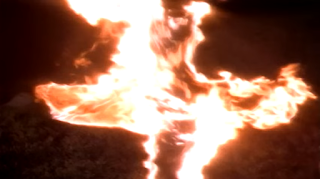Madonna : "Like a Prayer"
Controversy can be defined as a disputation concerning a matter of
opinion; in the case of Madonna's “Like a Prayer“, controversy is
brought up by several themes shown throughout the entirety of the
music video.
Controversial topics can be raised by things that can go against the “norm”, can make people uncomfortable, can express different ideologies, can be offensive, can be up-to date with current issues, can be scandalous, and can provoke a negative reaction.
Controversial topics can be raised by things that can go against the “norm”, can make people uncomfortable, can express different ideologies, can be offensive, can be up-to date with current issues, can be scandalous, and can provoke a negative reaction.
In Madonna's music video “Like a Prayer” from 1989, she seems to
address issues of racism and rape, which weren't positively picked up
by the public. The Vatican condemned the video, and families and
religious groups protested against the broadcast of the video. The
music video even boycotted Pepsi, who used it in one of their
commercials, and therefore canceled their contract with Madonna. She
was seen as the original rebellious artist.
 |
| 03:30 - "Like a Prayer" |
The music video immediately introduces Ku Klux Klan-style cross
burning, which did not transfer well to a wide audience, as it a)
negatively reinforced the churches' image, and b) re-introduced a few
issues the KKK had raised. The group used the burning of a Latin
cross as a display of symbolism and an attempt at intimidation in
around 1915, often accompanied by prayer, hymns and religious
symbolism.
 |
| 00:10 - "Like a Prayer" |
Through “The Clansman” by Dixon and “The Birth of a
Nation” by Griffith, the symbol of a burning cross has been
associated with the group ever since, and is therefore negatively
reflected. Due to the KKK being a rather large issue in the 1980's
(such as the shooting of four elderly black women in 1980, and the
lynching of Michael Donald in 1981), Madonna, who was seemingly
promoting the negative ideologies that the KKK reflects, was seen as
provocative as the audience was unsure how to react to these actions
and were made uncomfortable. Whether it was necessary for Madonna to
use this symbolism within her music video is debatable, as the video
reflects issues of racism and incorporates the church (which also
depicts a black Jesus, pastor and folk); it may have spoken out
against the group and/or it's ideologies. Whatever the causes were
for these symbols to be incorporated in the music video are
irrelevant, they were deemed as controversial because of Madonna
seemingly portraying a completely different ideology.
In her music video, she also represents other religious references
such as stigmata, which is a term used by members of Christian faith
to describe marks, sores or pain which correlate to the crucifixion
wounds which Jesus Christ has. Madonna portrays herself as a
Stigmatic in the video, as she is shown to have cuts on her hands
similar to those of Jesus.
 |
| 02:20 - "Like a Prayer" |
Ivan Illich, a Christian theologian created the theory
that stigmata is raised by the desire to associate oneself with the
suffering Jesus Christ went through. This can be seen as a
controversial topic as these themes could be viewed as an attempt to
provoke a reaction from the audience. By using stigmata within her
video, Madonna is concerned with the ideologies that religion raises.
Whilst this is not too endearing, the fact that she associates
herself with a black figure of Jesus could be provocative and cause
issues due to interracial contact with, and acceptance of a
darker-skinned Jesus.
 |
| 03:00 - "Like a Prayer" |
Because the music video portrays Madonna
witnessing a murder/an act of rape to a white girl by white
“supremacists”, and a black man coming to help the poor woman,
Madonna knows that the saviour is black. Therefore, Jesus (the
Messiah and saviour) is presented as being a black man in the video,
which some people may not have agreed with.
Through slight hints at intimacy with black Jesus, Madonna raises the
controversial issue of being up-to date, and also portrays a
scandalous image. In the 1980's a huge setback was caused for African
Americans within the U.S, which is where the music video seemed to
have taken place, due to Ronald Reagen's presidency whom seemed to
ignore most of their issues and interests. An array of conservative
judges at court often ended and shut down programmes which were
designed to help against racism, and therefore divided the nation
racially once more.
 |
| 04:24 - "Like a Prayer" |
 |
| 05:18 - "Like a Prayer" |
This is why, in the music video, the police
targeted the black man and arrested him without further questions,
whereas the actual offenders got away unharmed. In her music video
Madonna attempted to bring together both racial cultures, and seemed
to have no interest towards their skin colour. She is portrayed
celebrating the equality of race, and attempts to put a better light
on black people who are trapped in an unequal society through
portraying Jesus as a black man, portraying the saviour of the woman
to be black, and shown as standing in as a witness and bailing the
black man out of prison rightfully instead of embracing racism.
She
attempts to positively represent black people within her music video
and attempts to turn opinions around.
Overall, Madonna addresses racism in a satirical, and also in a
slightly ironic way. Whether all of the symbols within her music
video were right to use is unsure, however by being different and
controversial she attempts to speak out to those negatively
influenced by racism and addresses these issues by standing out.
Causing an outrage to happen may have helped bring the message across
easier.

0 comments:
Post a Comment